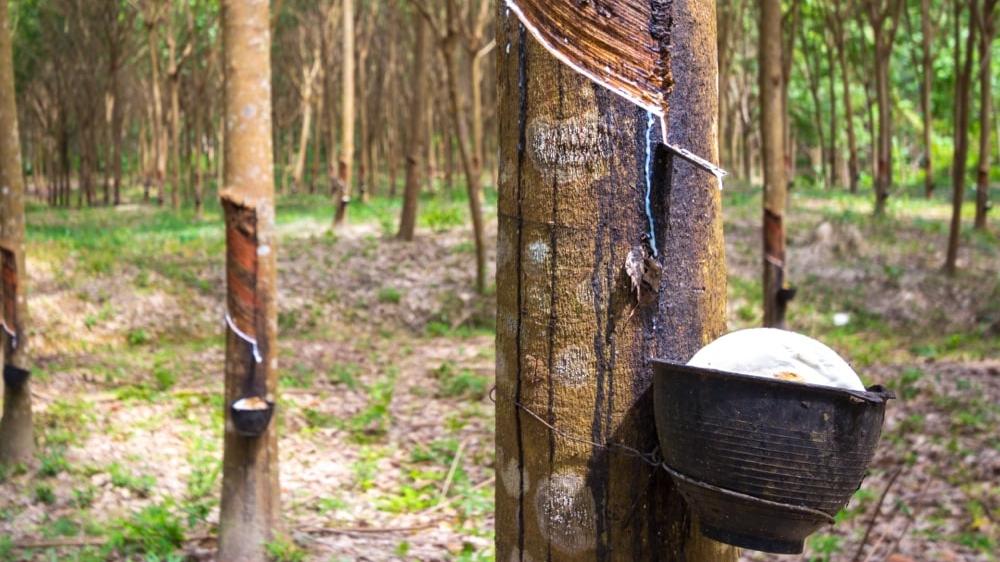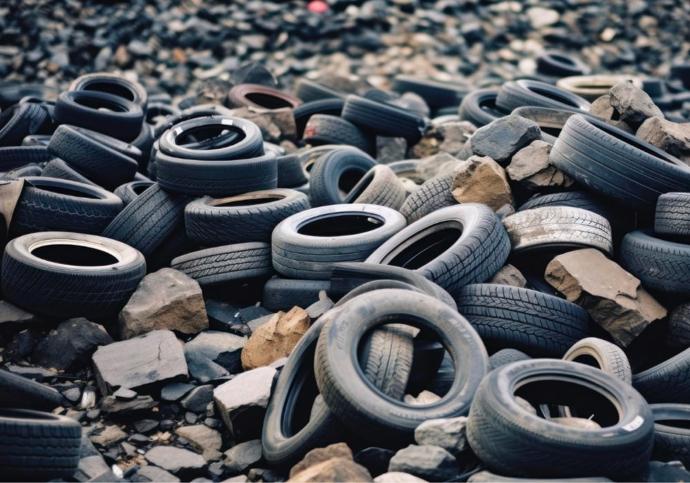Rubber is found in everything from vehicle tyres to medical devices and plays an important role in various sectors. The rubber industry is integral to modern manufacturing and daily life. However, as global demand continues to rise, we are experiencing numerous sustainability challenges with its supply and production. The production and disposal of rubber products have significant environmental and ethical implications. This article explores the sustainability of rubber, focusing on its production processes, impacts on both people and the environment, and the possibilities for recycling and biodegradation.
As the world leans more towards sustainability, the rubber industry stands at a crossroads. Rubber compound suppliers and manufacturers are increasingly pressured to improve practices, reduce environmental footprints and ensure ethical standards. These pressures prompt an examination of both natural and synthetic rubber, their production impacts and the potential for sustainable management within the industry.
What is Rubber?
Rubber is a versatile and essential material used across various industries due to its unique properties such as flexibility, water resistance and durability. It comes in two primary forms: natural rubber and synthetic rubber, each with distinct sources, production methods and applications. Understanding the differences between these two types of rubber is important for addressing the sustainability and ethical challenges they pose.
Natural Rubber
Natural rubber originates from the latex of rubber trees, primarily the Hevea brasiliensis, which is native to South America but now predominantly cultivated in Southeast Asia. The latex, a sticky milky liquid, is extracted through a process known as tapping. During this process, incisions are made in the bark of the rubber tree that allows the latex to drip out and be collected in containers. The raw latex is then refined into various grades of natural rubber, dependant on its intended use.
Natural rubber is valued for its high elasticity, tensile strength and resistance to abrasion and heat. It is indispensable in the manufacture of products like tyres, boots and gloves.

Synthetic Rubber
This compares to synthetic rubber that is manufactured through the chemical synthesis of petroleum by-products. The process involves the polymerisation of monomers like butadiene and styrene to form different types of synthetic rubber, such EPDM and nitrile rubber. Each type of synthetic rubber can be engineered to have specific properties suited to particular applications. For example, synthetic rubbers are used in making waterproof materials, insulation and elastomers that require resistance to oils and chemicals. The production of synthetic rubber is energy-intensive and depends heavily on the availability of non-renewable petroleum resources, which raises significant environmental concerns.
Is Rubber Sustainable and Ethical?
Both natural and synthetic rubbers play important roles in global industries but differ in their environmental footprints and the sustainability challenges they present.
The question of sustainability and ethics is complex and multifaceted and reflects a range of broader concerns about environmental impact, human rights and economic viability. As rubber is an essential material for numerous applications, its production and use have significant implications for people and the planet.
Impact on People
The human aspect of rubber production, particularly natural rubber, involves several ethical concerns. Many rubber plantations are located in developing countries where regulations may be less stringent. This can lead to issues such as the exploitation of workers, unsafe working conditions and inadequate pay. For instance, in some countries, workers are exposed to hazardous conditions without proper protective equipment or training which may lead to health risks and accidents. Additionally, the demand for land to expand rubber plantations often leads to land conflicts with local communities, displacement of indigenous peoples and alteration of local economies.
Child labour is another serious concern in the rubber industry, with reports from various organisations highlighting the use of underage workers in hazardous conditions on rubber plantations. These ethical issues are compounded by the economic practices within the industry, where fluctuations in global rubber prices can cause significant instability for those whose livelihoods depend on rubber farming. Such economic vulnerability makes it difficult for producers to invest in sustainable and ethical practices.
Impact on the Environment
Environmental sustainability in the rubber industry is jeopardised by both the cultivation of natural rubber and the production of synthetic rubber. Natural rubber cultivation is often associated with deforestation which has implications for biodiversity, carbon storage and the climate. Expanding rubber plantations can lead to the loss of ecologically important areas, such as rainforests in Southeast Asia and Africa. This not only disrupts local ecosystems but also contributes to global issues like climate change due to the release of stored carbon dioxide when forests are cleared.
Synthetic rubber production also poses different environmental challenges. It relies heavily on fossil fuels as a raw material and an energy source for manufacturing processes. This is leading to significant carbon emissions that are contributing to global warming. Additionally, if not properly managed, the chemical-intensive nature of synthetic rubber production can result in pollution of air, water and soil. The release of volatile organic compounds (VOCs), hazardous air pollutants and other by-products can have detrimental effects on environmental health and human well-being.

Is Rubber Biodegradable?
Biodegradability is an important aspect of assessing the environmental impact of materials such as rubber. Understanding whether rubber can break down naturally in the environment is essential for evaluating its sustainability and potential ecological footprint. The biodegradability of rubber varies significantly between its two main types, natural and synthetic, each behaving differently when exposed to natural conditions.
Natural Rubber
Natural rubber is inherently biodegradable. Its organic origin allows microorganisms present in the environment to decompose its structure. The rate and extent of degradation will depend on factors such as temperature, microbial activity and the presence of oxygen and moisture.
While pure natural rubber is biodegradable, the presence of additives in the rubber can complicate the biodegradation process. Many commercial natural rubber products contain various chemicals added to enhance properties such as elasticity, toughness and resistance to heat and chemicals. For example, vulcanization which involves adding sulfur to improve durability and elasticity, can make natural rubber products like tyres and shoe soles much less prone to biodegradation.
Synthetic Rubber
Synthetic rubber presents a more challenging scenario in terms of biodegradability. It is primarily made from petroleum-based materials and often consists of polymers which are not readily biodegradable. The synthetic nature of these materials means they are designed to be highly durable and resistant to environmental factors that typically promote natural decomposition.
The resistance to biodegradation in synthetic rubbers is a significant environmental concern because it leads to long-term persistence in landfills and natural habitats. The accumulation of waste synthetic rubber products, particularly tyres, in the environment can have detrimental ecological impacts. These products can leach harmful chemicals into the soil and waterways, pose hazards to wildlife and contribute to the growing problem of micro plastics in the oceans.
Given the challenges associated with the biodegradation of rubber, especially synthetic compounds, it is important to explore new formulations. Developing new formulations that make rubber products more compatible with biodegradation processes can also play a significant role in addressing the environmental issues posed by rubber products.
Can Rubber Be Recycled?
Recycling rubber is an important aspect of reducing the environmental impact associated with its production and waste. Rubber, both natural and synthetic, poses significant challenges in waste management due to its durability and resistance to degradation. However, advances in recycling technologies and increased awareness of environmental sustainability have led to improved methods for repurposing used rubber.
Rubber recycling involves several processes that can vary depending on the type of rubber and the intended reuse applications. The most common method is mechanical grinding, where rubber products are shredded into granules. These granules can then be used to produce a variety of products, including athletic tracks, playground surfaces and sometimes included in other rubber products. Another method is devulcanization, which refers to the process of reversing the vulcanization of rubber to revert it back to its original state. This allows the recycled rubber to be remoulded and reused in new products.
For synthetic rubbers, chemical recycling can be an option. This process involves breaking down the rubber into its constituent chemicals which are then reused in the production of new rubber or other materials. Although chemical recycling is more energy-intensive and complex, it provides a way to recycle rubbers that are difficult to process mechanically.
Challenges in Rubber Recycling
Despite the existence of these recycling methods, several challenges impede widespread rubber recycling. First, the presence of some additives in rubber can complicate the recycling process and make it difficult to recover pure rubber. Economic factors also play a significant role as the cost of recycling can sometimes exceed the cost of producing new rubber, especially when oil prices are low. This reduces the economic incentive to recycle.
The mixed nature of rubber waste, which often contains a combination of both natural and synthetic rubbers along with other materials like metal and fibre, further complicates recycling efforts. Sorting and separating these materials can be costly and technologically demanding due to the way they are often manufactured as one profile. The quality of recycled rubber is also generally inferior to that of virgin rubber, which is a limiting factor in high-quality applications.
Despite these challenges, recycling rubber brings substantial environmental and economic benefits. It significantly reduces the volume of waste sent to landfills and minimises the environmental pollution caused by illegal dumping. Recycling also conserves resources by reducing the demand for new raw materials and decreases energy consumption associated with the production of new rubber. Economically, it can create new markets and job opportunities in the recycling and manufacturing industries.
Future Perspectives of Rubber Recycling
The future of rubber recycling depends largely on technological advancements, improved economic viability and regulatory support. Enhancing recycling technologies to make them more efficient and less costly is important. Creating regulatory frameworks that encourage the recycling of rubber through incentives and mandates can also drive the adoption of recycling practices. Public awareness and education about the benefits of rubber recycling can also play a role in increasing recycling rates.
Moving Towards a Sustainable Future
Seals Direct is deeply committed to promoting the responsible use and manufacture of rubber products. Recognising the significant environmental and ethical challenges associated with rubber production, Seals Direct is working to implement processes that help with sourcing ethically produced natural rubber and utilising recycling technologies to minimise excess production waste.
To find out more about the various rubber materials we offer, feel free to contact our knowledgeable team. You can give us a call by phone on 01425 617722 or submit your enquiry via email to sales@sealsplusdirect.co.uk.